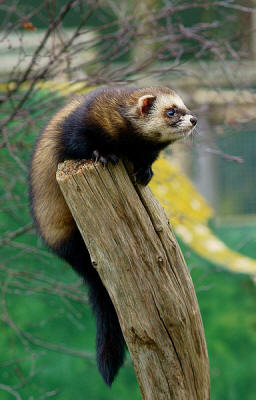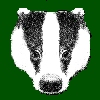 |
Polecats

 Polecats are related to the badger. Polecats are related to the badger.
The European polecat (Mustela putorius), also known as the black or forest
polecat (as well as a host of other names), is a species of mustelid native to
western Eurasia and North Africa. It is of a generally dark brown colour, with a
pale underbelly and a dark mask across the face. Occasionally, colour mutations,
including albinos and erythrists, occur. Compared to weasels and minks, the
polecat has a shorter, more compact body, a more powerfully built skull and
dentition and is less agile in its movements.
It is much less territorial than other mustelids, with animals of the same
sex frequently sharing home ranges. Like other mustelids, the European polecat
is polygamous, though pregnancy occurs directly after mating, with no induced
ovulation. It usually gives birth in early summer to litters consisting of five
to 10 kits, which become independent at the age of two to three months. The
European polecat feeds on small rodents, birds, amphibians and reptiles. It
occasionally cripples its prey by piercing its brain with its teeth and stores
it, still living, in its burrow for future consumption.
The European polecat originated in Western Europe during the Middle
Pleistocene, with its closest living relatives being the steppe polecat, the
black-footed ferret and the European mink. With the two former species, it can
produce fertile offspring, though hybrids between it and the latter species tend
to be sterile, and are distinguished from their parent species by their larger
size and more valuable pelts.
The European polecat is the sole ancestor of the
Ferret, which was domesticated more than
2000 years ago for hunting vermin. Polecats have been historically viewed
negatively by humans. In the British Isles especially, the polecat was
persecuted by gamekeepers, and became synonymous with promiscuity in early
English literature. During modern times, the polecat is still scantly
represented in popular culture when compared to other rare British mammals, and
misunderstandings of its behaviour still persist in some rural areas. |
